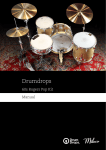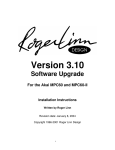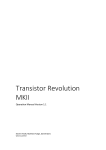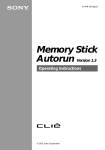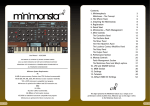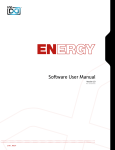Download Pinnacle Trigger Finger
Transcript
Gearhead Gearhead Gearhead Gearhead Gear Gearhead Gearhead Gear M-AUDIO KEY RIG with modeled options, several filter types, envelopes for the filter and amp, multiple modulation options, and a surprisingly complete collection of effects. The SP-1 could have stopped at just playing back a nice piano, but you can layer (or split) two pianos, chosen from a bunch of presets. And yes, there are a bunch of effects too. There’s no sample playback module à la EXS24, but the GM module includes a good General MIDI set and should cover your, uh, general needs. The organ holds its own against the world of “Beethreewannabes,” with virtual drawbars and a decent rotary simulation. All the instruments let you assign controllers to the various parameters for realtime control, with a simple “learn” option so you don’t have to think about assignments too much, either. The GM module and organ don’t have a bunch of effects, but there is a master effects section with one effect chosen from a relatively extensive menu, and each instrument has a send control for driving it. A few other welcome touches include the ease of setting up splits (you can set each instrument to its own keyrange, pan, gain trim, level, and MIDI channel). I’d give Key Rig very high marks for striking a near-perfect balance of ease of use, cost, and editability. It takes a bit of a hit on your CPU, but hey, it’s four instruments and you might not need to load a bunch of other stuff anyway. Yes, it’s a scratch pad — but with fine vellum paper, along with a pen that doesn’t run and offers a choice of inks. Key Rig is an ideal stocking stuffer that offers exceptional value for money. (PS: And if you still have some disposable income, there’s an equally cost-effective Drum and Bass Rig with a step sequencer bassline synth, drum module, loop creator, and electric bass guitar module.) —Craig Anderton M-Audio Trigger Finger Got an itchy trigger finger for great rhythm programming? Of course, you do. by Mitch Gallagher Programming drums can be a pain in the ass. Plunking in little dots on a grid with a mouse is painfully tedious, and often results in lame, rigid rhythms — which is fine, if you’re into that sort of thing. But if you’re after feel, mousing in drum and percussion parts isn’t going to cut it. Yes, you can use a MIDI keyboard to play in parts. But the black-and-whites aren’t exactly designed for the task. It works, but it’s not “natural,” especially for non-keyboard players. For great-feeling drums and percussion, my opinion says that pad controllers are the way to go. High-priced boxes like the MPC60 and its progeny do the job, but they’re, well, high-priced. And they do way more than just serve as pad controllers. That’s wonderful if your MPC is the main instrument you build your tracks around. But if you’re like me and you just want some pads for playing in drum parts with some feel, then an MPC is overkill. MIDI drum pads are excellent if you’re a drummer or are handy with sticks. But I’m not — I want something I can bang on with my fingers. 52 EQ JAN UARY 2006 www.eqmag.com That’s where the M-Audio Trigger Finger comes in. This affordable box has 16 velocity- and pressure-sensitive pads that you can use for playing sampled drums, triggering loops, sending MIDI messages, or doing whatever you want to use MIDI events to trigger or control. As a bonus, there are eight assignable control knobs and four assignable sliders for controller parameters, mixer settings, or anything else. You can create 16 preset “maps” for accessing your drum layouts, loops, or control needs, and quickly switch among them as you move from application to application. It doesn’t get much simpler than the Trigger Finger. Install the driver on your Mac or PC, then connect the Trigger Finger to your computer using the supplied USB cable. Launch Reason, Live, or a host DAW running a plug-in instrument such as Battery, Kontakt, or MachFive — whatever you’re using for your sounds — and start smacking the pads, cranking knobs, and flicking sliders. Alternatively, connect Trigger Finger’s MIDI out to your keyboard or sound module, and start playing. As the annoying TV ad guy says, “It’s really that easy.” The Trigger Finger can draw power over the USB connection, or you can use it with an optional 9-volt power supply. The MIDI out can either send MIDI messages generated inside the Trigger Finger to another MIDI device, or it can serve as a MIDI output for a computer that’s connected via USB, turning the Trigger Finger into a 1-out MIDI interface. Enigma Trigger Finger can send out a very wide variety of MIDI messages, from notes to The free Enigma Editor/Librarian allows complete access to every programmable control in the Trigger Finger control surface. controllers to pitch bend to aftertouch. The pads can all be on one MIDI channel or each can send on its own channel. In short, this thing has far more MIDI capability than you’d think from looking at it — in reality, it has more MIDI capability than most (if not all) of us will ever use. To harness all that power, M-Audio provides a free downloadable editor called “Enigma,” which actually supports a variety of M-Audio control devices. With Enigma, you can address every programmable parameter in the Trigger Finger, and build up a library of presets. Enigma is compatible with both Mac and Windows. Install it on your computer, launch, and it will automatically find Trigger Finger and be ready for action. The user interface is simple; click on the control you want to change, and make whatever settings you need. Or you can drag parameters to Trigger Finger pads and controls. There are parameter lists included for a number of common instruments, which makes it easy. Select Gmedia’s Oddity (for example) from the library, and all the Oddity’s controllable parameters are listed. Just drag a parameter from the list to the pad, knob, or slider you want to use, and you’re done. For quick changes (especially of the notes assigned to the pads), you can program Trigger Finger from the front panel — just hold the Memory Recall and Prog/Bank Change buttons to enter Edit mode. Then, to change the note assigned to a pad (for example), hit the desired pad, then turn the first control knob. The LCD readout will change to display the note assigned to the pad. Easy. But if you really want to use Trigger Finger to its fullest, and you need to create highly customized programs, Enigma is definitely the way to go. Using It Trigger Finger is excellent for the obvious application: playing drum sounds. It worked great with Reason for playing ReDrum and other samples, and for programming MIDI tracks in Digital Performer, Pro Tools, Logic Pro, and others. It also worked great for simply playing sounds; FM7, Pro-53, Korg’s Wavestation plug-in, on and on, anything that could be played by MIDI was cool with Trigger Finger — PRODUCT SUMMARY Type: Pad-, knob-, and slider-based MIDI controller Price: $249.95 Contact: M-Audio, m-audio.com Connections: USB out, MIDI out, 9-volt DC input USB Support: Mac OS X 10.2.8 or higher, Windows XP Compatibility: MME, DirectX, Core MIDI Presets: 16 Pre-programmed maps: Live, Reason, GM Drum, XG Drum, iDrum Assignable Controls Pads: 16 velocity- and pressure-sensitive Sliders: 4 Knobs: 8 Dimensions: 11" (w) x 10" (d) x 2-1/4" (h) Power: USB or optional 9-volt DC adapter Software Bundle includes: Drivers, Ableton Live 4 Lite, Enigma editor www.eqmag.com JAN UARY 2006 EQ 53 Gearhead Gearhe for more than just percussion. Bass lines were easy to do with Trigger Finger, and the fact that the pads are both velocity- and pressure-sensitive was nice. You can assign any MIDI controller to be sent when you apply pressure to each pad, so you can have a very broad range of expressive possibilities available to you — this worked great with synths like Arturia’s Minimoog V. Of course, you can also use the knobs and sliders to send MIDI controllers, which is great. But being able to dynamically apply pressure from the pads can really bring a performance to life. Above all, the Trigger Finger and its soft rubber pads makes programming — I really should say “performing” — drum and percussion parts fun. No more hours slaving over a grid or typing in data. Hit the record button and play. It’s a blast, and it makes a real difference in the sound and feel of your MIDI drum and percussion tracks — just avoid he urge to click the “quantize” button in your software! Is It Cool? Yes, it’s cool! In fact, at under $200 street price, the Trigger Finger is an easy EQ Exceptional Quality award winner — there isn’t anything in its price range that comes close. It’s very easy to use, has a free software editor and includes a “Lite” version of Ableton’s Live 4. Just plug it in and go. I was making tracks in Reason within seconds of connecting the USB cable. The pads feel good, they’re dynamic in their response, and the eight sliders and four faders are incredibly handy. Basic programming from the Trigger Finger itself is not a problem, and for more in-depth programming, Enigma takes you as far as you want to go. About the only thing I wish it had was a power switch. I’ve been waiting for someone to come out with something like the Trigger Finger for a while, and at this price, M-Audio has made me and my drum and percussion parts very happy. Trigger Finger is staying in my studio. Strengths: ■ 16 velocity- and pressure-sensitive pads ■ Can be powered from USB ■ Easy installation ■ Comprehensive MIDI support ■ Easy pad and controller programming ■ Free Enigma editor for Mac and PC Limitations: ■ No power switch 54 EQ JAN UARY 2006 www.eqmag.com



